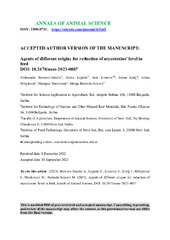Prikaz osnovnih podataka o dokumentu
Agents of different origins for reduction of mycotoxins’ level in feed
| dc.creator | Bočarov-Stančić, Aleksandra | |
| dc.creator | Lopičić, Zorica | |
| dc.creator | Krstović, Saša | |
| dc.creator | Krulj, Jelena | |
| dc.creator | Milojković, Jelena | |
| dc.creator | Maslovarić, Marijana | |
| dc.creator | Bodroža-Solarov, Marija | |
| dc.date.accessioned | 2024-01-12T08:34:40Z | |
| dc.date.available | 2024-01-12T08:34:40Z | |
| dc.date.issued | 2023 | |
| dc.identifier.issn | 2300-8733 | |
| dc.identifier.uri | https://ritnms.itnms.ac.rs/handle/123456789/1217 | |
| dc.description.abstract | Toxic secondary metabolites of some fungi (mainly representatives of Alternaria, Aspergillus,Fusarium and Penicillium genera) may contaminate agricultural products, representing serioushealth hazards both to humans and animals. Along with this, the economic losses due to themycotoxins’ presence in feed production, including crop and animal feedstuff processing anddistribution, motivated the plentiful research of detoxification strategies. Feed supplementationwith mineral adsorbents (zeolites, hydrated sodium calcium aluminosilicate (HSCAS),bentonites, etc.) is the most prominent approach widely applied. Besides these, other productsfor mycotoxin level reduction based on the constituents of the yeast cell wall or Lactobacilliare often used. Recently, many investigations are directed toward plant-derived products thatcan efficiently adsorb mycotoxins in their native (biosorbents) or modified forms (e.g. activatedcarbon, biochar etc.). These renewable, easily accessible and readily prepared sorbents areeconomically viable and safe alternatives for mycotoxin decontamination of feed resources.Organic polymers (chitosan, cellulose, etc.) as well as synthetic polymers, such as polyvinylpyrrolidine, also might reduce mycotoxins’ level in feed. Besides these conventional methods,new research trends are nanotechnologies, the promising, effective, low-cost way formycotoxins’ removal. This overview systematically summarizes information on binding agentsof different origins for the reduction of mycotoxins’ levels in feed. Furthermore, the knowledgeof potential applications of binding agents in the feed industry is also reviewed and discussed. | sr |
| dc.language.iso | en | sr |
| dc.publisher | Sciendo | sr |
| dc.relation | info:eu-repo/grantAgreement/MESTD/inst-2020/200023/RS// | sr |
| dc.relation | info:eu-repo/grantAgreement/MESTD/inst-2020/200051/RS// | sr |
| dc.relation | info:eu-repo/grantAgreement/MESTD/inst-2020/200168/RS// | sr |
| dc.rights | openAccess | sr |
| dc.rights.uri | https://creativecommons.org/licenses/by/4.0/ | |
| dc.source | Annals of Animal Science | sr |
| dc.subject | mycotoxins reduction | sr |
| dc.subject | feed | sr |
| dc.subject | mineral adsorbents | sr |
| dc.subject | plant-derived products | sr |
| dc.subject | polymers | sr |
| dc.subject | nanoparticles | sr |
| dc.title | Agents of different origins for reduction of mycotoxins’ level in feed | sr |
| dc.type | article | sr |
| dc.rights.license | BY | sr |
| dc.identifier.doi | 10.2478/aoas-2023-0087 | |
| dc.identifier.fulltext | http://ritnms.itnms.ac.rs/bitstream/id/2822/Agents-of-different-origins-for-reduction-of-mycotoxins-level-in-feed.pdf | |
| dc.type.version | publishedVersion | sr |

